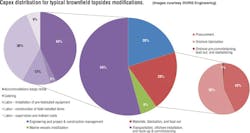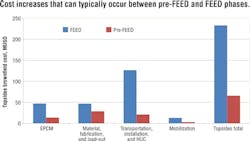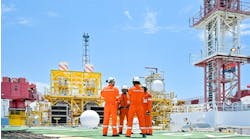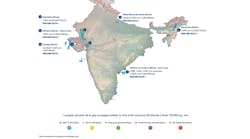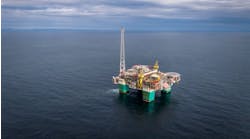Vincent Fort • Stéphane Taxy
DORIS Engineering
Several majordeepwater fields have been developed over the past 20 years in the Gulf of Mexico, West Africa, and Brazil. Many of these projects are now maturing, and tapping into satellite fields to extend the plateau or mitigate production decline has become the focus of an increasing number of initiatives. This approach maximizes the use of the giant infrastructures built to process and offload the million barrels of hydrocarbons recovered in the initial phase of the developments.
Because of the high capex associated with drilling and subsea facilities, deepwater tiebacks are often categorized as major capital projects. In this context, topsides brownfield modifications are seldom viewed as a major contributor to the overall project costs. However, the economics of asubsea tieback are generally sensitive. The various constraints and challenges that come with the integration of new facilities on an operating platform can lead to a significant growth of the development cost and jeopardize its feasibility if they are not kept to a strict minimum.
Compared to a typical drilling cost of $80 to $100 million/well or an average pipelay vessel rate of $500,000 to $800,000/day, the cost of installing a few pieces of topsides equipment would appear to be several orders of magnitude lower than the capital investment required to drill the wells and develop thesubsea part of the tieback. The same holds true considering the amount and weight of materials to be installed topside compared to the kilometers of subsea flowlines, umbilicals, and wellbore necessary to bring the effluent back to the surface. It is however important to note that the potential loss of production generated by the tieback connection is not taken into account in the project costs, based on the assumption that most tie-ins will be performed during a maintenance shutdown.
Brownfield economics
Yet, and however unimportanttopsides modifications appear in the overall framework of a deepwater subsea tieback, they still represent a cost that should not be overlooked for two main reasons. The first reason is that the economics of a brownfield project are usually on the borderline of profitability. Topsides modifications on a fully functioning platform are costly, because of loss of production during potential shutdowns, and because of the lower efficiency associated with performing the work offshore, on a live facility. In other words, the facilities installed offshore for brownfield projects come at a higher cost than for greenfield projects. The leverage effect on the capex of the constrained environment under which construction activities are performed (offshore, on operating facilities) makes it necessary to define and quantify the scope of work to a level detailed enough to avoid unforeseen budget slippages during the execution phase. The second reason is related to uncertainties in the surrounding environment. These include the availability of an up-to-date as-built dossier, including modifications made after start-up; feedback from field operations on how the equipment performs and/or is actually run; and actual platform condition (asset integrity). Finding a pertinent design for the brownfield modifications is hence very often a challenging task, with the increased complexity that the proposed design shall be constructible at minimum cost.
Emphasizing select technical disciplines
The disciplines and subjects that are worth exploring in details during front-end engineering and design (FEED) can be determined by analyzing how the project’s capex will be allocated during the EPIC phase.
Cost cutting exercises are generally associated with weight reduction exercises, based on the general wisdom that the cost of a project is directly related to the weight of the equipment to be added on the platform. However, procurement of equipment packages and bulk materials typically only accounts for less than 10% of the overall topsides cost. This suggests that weight considerations cannot be used as the sole indicator to estimate the future cost of a project. Even though some correlation between weight and as-installed cost can be found, the specificities of each project make it difficult to define a ratio that can be generalized to a variety of cases. The design, installation, and operational constraints particular to a given development are likely to introduce enough bias to perturb cost predictions by a significant amount.
Installation-related costs account for more than half of the overall topsides cost. In other words, the benefits of a cost reduction exercise are likely to remain limited if they focus on weight reduction without challenging the overall design concept. The focus and optimization of the design effort shall be on constructability, with a view of minimizing the amount of offshore manhours. This will impact labor costs, logistics costs, as well as accommodations cost.
In the early stages of a FEED, and in the absence of a consolidated cost estimate, the subject then becomes the determination of a set of indicators that will best help select between various alternate scenarios. This usually happens at the start of the second stage of a FEED, which can be broadly decomposed in three phases: verification on existing facilities, design optimization, and engineering development.
Verifications, design optimization
The first weeks of the subsea tieback project FEED provide a good opportunity to optimize the scope of the topsides brownfield works and streamline the facilities to be added to the platform. The objective here is not so much to reduce procurement costs, but to minimize offshore integration works.
Pre-FEED works are usually more focused on the subsea end of the tieback’s development and only tend to outline a base case architecture for the topsides. With the increase of manpower that comes with the start of the next phase, and the mobilization of the contractor’s engineering team, the beginning of the FEED provides a good opportunity for optimization. This is achieved by using actual site measurements/surveys and feedback from field operations to fine tune the bases of design and possibly eliminate equipment that may have been deemed required as a first approach, but can be removed upon further review of the actual operating data provided by the platform. Vast amounts of information are routinely collected by thousands of sensors connected to the platform’s control system. This data can be used to calibrate process simulations and to assess the overall condition of the existing facilities with a view to guarantee their ability to produce the new fluids and possibly extend their design life. However, these data are not always readily available, and the beginning of the FEED tends to be oriented toward adding more definition to the pre-FEED, without taking a step back and challenging each piece of new equipment.
These first weeks shall also be used to collect and analyze as-built data. This will require early involvement of some disciplines that do not typically start their work until the design has significantly progressed. In addition to the various documents and drawings part of the as-built dossier, every effort should be made to obtain the 3D model of the existing facilities. Knowing that such a 3D model is seldom available or up-to-date, it is expected that a 3D laser scan of the platform shall be carried out anyway, if justified by the extent of the project’s scope and/or the accuracy of the model. The availability of this information at the start of FEED will be a first step toward meeting the overall FEED schedule. Ideally, data collection will have been performed during the pre-FEED phase.
These early works will be carried out with the objective of preparing for the first milestone of the FEED, which is the site survey. Its timing is a compromise between progressing the design enough for the survey to be meaningful, but leaving enough options open to minimize potential re-do as a results of site survey findings.
FEED planning
Although a sharp increase is observed in all of the main line items that constitute the overall budget, installation costs are found to exhibit the most noticeable rise. These are not only the main component of the overall budget; they also represent the most volatile fraction of the estimate. One of the reasons is that there is no middle ground when estimating offshore manhours. Pre-FEED studies are very seldom carried-out up to a level of details that would allow the use of precise estimating tools.
However, the accurate evaluation of the offshore integration costs is indeed the challenge of the early phases of a brownfield project.
In a greenfield project, procurement, fabrication and load-out account for about 75% of the total EPIC cost. Moreover, a satisfactory level of precision can easily be obtained when estimating these costs, i.e. the uncertainties associated to most of the main driving variables can be reduced with a minimum of effort. Procurement costs may be validated though quotations from suppliers, while construction costs can be quite accurately estimated using ratios applied to material quantities. The value of these ratios will vary from one yard to another, but as the works are performed on a facility which primary purpose it to create a favorable setting for construction activities, providing reliable ratios from past experience is achievable.
On the other hand, procurement, fabrication and load-out only account for less than 25% of the cost of a typical brownfield project. Instead, more than 50% of the capex comes from installation and offshore integration. Except for the installation of large pre-fabricated modules that may require a full production shutdown, these activities are performed on a live facility which primary purpose is to safely maximize oil production rather than provide an optimized environment for construction activities.
To summarize, roughly 75% of the cost of a greenfield project can be assessed with a reasonable good precision, while 50% of the cost of a brownfield project is highly dependent on variables that are much more difficult to accurately quantify.
A first step in reducing the uncertainties related to the offshore execution is to provide enough granularities in the input data to the planning studies. This means extracting material take-offs for most of the disciplines that will be used as a basis for offshore construction works durations, as well as preparing a detailed list of the tasks to be performed offshore, including decommissioning activities and modifications required for the proper integration of the new equipment to be installed on the platform. Such modifications of the host platform are often overlooked at FEED stage, although they typically represent a significant part of the offshore manhours. Indeed, planning studies often focus on confirming the duration of the platform shutdown required for heavy lifting and tie-in activities. Other activities that do not occur during this critical phase of the works should nevertheless be anticipated as early as possible, as they represent a significant amount of work.
Removing the uncertainties associated with estimating the installation costs thus requires to take the studies one step further than the typical scope intended at a given project phase. In other words, for a brownfield development, the outcome of the FEED phase should more or less correspond to what is expected from a detailed engineering in a greenfield.
This objective will reflect in the relative importance of each discipline budget in the overall project budget.
The main objectives of a greenfield project are to develop specifications and datasheets for the various pieces of equipment to be purchased, as well as to provide drawings and material take-offs for the main bulks, i.e. piping and structure. This yields a rather uneven distribution for the expenditures, with the process, piping/layout, and structural engineering disciplines combining for more about 75% of the total expenditures.
In the case of a brownfield, these three disciplines only combine for slightly more than 50% of the total cost. Overall, the cost distribution is more evenly balanced across the various disciplines, which is mainly explained by the need to have better definition throughout the various areas of the project, including such disciplines as E&I which may not be progressed in as many details in a greenfield project.
Integrating FEED into project phasing
The need to take FEED studies to a higher level of maturity, both in terms of details as well as in terms of scheduling, blurs the lines between FEED and detailed engineering.
Under the classical framework of an offshore field development, the completion of the FEED phase is followed by the launch of a call for tender for an EPIC contract. Except for some long lead items, the EPIC contractor is expected to be in charge of procuring most of the equipment and bulk for the new facilities.
Because of their comparatively reduced size, brownfield projects may be less likely to attract the main international EPIC contractors. The list of potential bidders is expected to be made of smaller size local contractors with limited engineering capabilities and a core business oriented toward fabrication and offshore installation.
A way forward in terms of brownfield project phasing would thus be to carry out detailed engineering studies as a direct continuation of the FEED works. This approach is only valid if the design has been frozen enough at the end of the FEED phase. In that framework, the same engineering contractor would carry out both front-end and detailed engineering, but would also be responsible for the procurement of most of the equipment and bulk. The engineering activities performed by the EPIC contractor would then be mainly limited to construction and installation engineering.
This approach calls for the early integration of construction, installation and pre-commissioning specialists into the design team. This approach also requires a change of perspective from the FEED contractor, from a design-oriented mindset focused on outlining the key characteristics of the field development, to a construction-oriented approach aiming at optimizing the offshore integration phase, while taking the design to a higher level of definition.
The skillset of the engineering team shall therefore combine a good understanding of a project’s key drivers that will allow defining the main orientations of the design, together with enough technical expertise to be able to develop the design to the required level of details.
Acknowledgment
This article is based on a paper presented at theOffshore West Africa Conference & Exhibition held in Lagos, Nigeria, Jan. 26-28, 2016.
